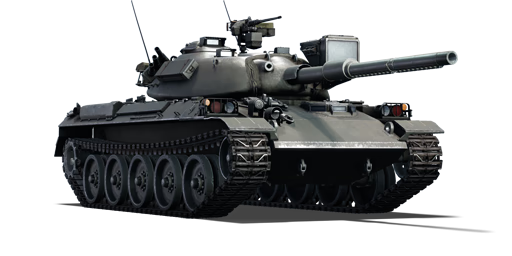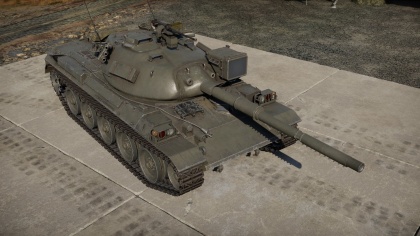Type 74 (E)
Contents
| This page is about the Japanese medium tank Type 74 (E). For the premium version, see Type 74G. |
Description
The Type 74 (E) is a rank VI Japanese medium tank
with a battle rating of 9.0 (AB/RB/SB). It was introduced along with the initial Japanese Ground Forces tree in Update 1.65 "Way of the Samurai".
General info
Survivability and armour
Armour type:
- Rolled homogeneous armour
- Cast homogeneous armour (Gun mantlet)
| Armour | Front | Sides | Rear | Roof |
|---|---|---|---|---|
| Hull | 40 mm (74°), 80 mm (65°) Front glacis 80 mm (57°) Lower glacis |
35 mm (44°) Top 30 mm, 10 mm (55-56°) Bottom |
20 mm Top 25 mm (47-48°) Bottom |
25 mm |
| Turret | 132 mm (27-53°) Turret front 200 mm (34-73°) , 150 + 170 mm (0-44°) Gun mantlet |
132 mm (5-57°) Front 67 mm (37-47°) Rear |
37 mm (17-39°) | 67 mm Front 37 mm Rear |
| Armour | Sides | Roof | ||
| Cupola | 80 mm | 80 mm |
Notes:
- Suspension wheels and tracks are both 20 mm thick.
- The Type 74's hydropneumatic suspension means it could vary the sloped angle of its armour towards the enemy.
- Hull roof is rated to be 25 mm effective against HE.
Mobility
| Game Mode | Max Speed (km/h) | Weight (tons) | Engine power (horsepower) | Power-to-weight ratio (hp/ton) | |||
|---|---|---|---|---|---|---|---|
| Forward | Reverse | Stock | Upgraded | Stock | Upgraded | ||
| Arcade | 59 | 9 | 38 | 1116 | 1,660 | 29.37 | 43.68 |
| Realistic | 54 | 8 | 637 | 870 | 16.76 | 22.89 | |
Armaments
Main armament
| 105 mm L7A3 | Turret rotation speed (°/s) | Reloading rate (seconds) | |||||||||||
|---|---|---|---|---|---|---|---|---|---|---|---|---|---|
| Mode | Capacity | Vertical | Horizontal | Stabilizer | Stock | Upgraded | Full | Expert | Aced | Stock | Full | Expert | Aced |
| Arcade | 50 | -6°/+9° | ±180° | Two-plane | 22.8 | 38.1 | 38.4 | __._ | __._ | 8.7 | 7.7 | __.__ | 6.7 |
| Realistic | 14.3 | 20.3 | 20.4 | __._ | 24.0 | ||||||||
Ammunition
| Penetration statistics | |||||||
|---|---|---|---|---|---|---|---|
| Ammunition | Type of warhead |
Penetration @ 0° Angle of Attack (mm) | |||||
| 10 m | 100 m | 500 m | 1,000 m | 1,500 m | 2,000 m | ||
| M735 | APFSDS | 353 | 350 | 342 | 333 | 322 | 312 |
| Type 75 | HESH | 127 | 127 | 127 | 127 | 127 | 127 |
| Type 91 | HEATFS | 400 | 400 | 400 | 400 | 400 | 400 |
| Type 93 | APFSDS | 405 | 403 | 396 | 388 | 378 | 370 |
| Shell details | ||||||||||
|---|---|---|---|---|---|---|---|---|---|---|
| Ammunition | Type of warhead |
Velocity (m/s) |
Projectile Mass (kg) |
Fuse delay (m) |
Fuse sensitivity (mm) |
Explosive Mass (TNT equivalent) (g) |
Normalisation at 30° from horizontal |
Ricochet | ||
| 0% | 50% | 100% | ||||||||
| M735 | APFSDS | 1,501 | 3.7 | N/A | N/A | N/A | +1.5° | 76° | 77° | 80° |
| Type 75 | HESH | 760 | 10.8 | 0.4 | 0.1 | 2,700 | +0.0° | 73° | 77° | 80° |
| Type 91 | HEATFS | 1,150 | 10.5 | N/A | 0.1 | 1,271 | +0.0° | 65° | 72° | 77° |
| Type 93 | APFSDS | 1,501 | 3.4 | N/A | N/A | N/A | _._° | 78° | 80° | 81° |
| Smoke shell characteristics | ||||||
|---|---|---|---|---|---|---|
| Ammunition | Velocity (m/s) |
Projectile Mass (kg) |
Screen radius (m) |
Screen deploy time (s) |
Screen hold time (s) |
Explosive Mass (TNT equivalent) (g) |
| M416 | 730 | 11.4 | 20 | 5 | 25 | 50 |
Ammo racks
| Full ammo |
1st rack empty |
2nd rack empty |
3rd rack empty |
4th rack empty |
5th rack empty |
6th rack empty |
Visual discrepancy |
|---|---|---|---|---|---|---|---|
| 50 | __ (+__) | __ (+__) | __ (+__) | __ (+__) | __ (+__) | __ (+__) | __ |
Optics
| Type 74 (E) Optics | ||
|---|---|---|
| Default magnification | Maximum magnification | |
| Main Gun optics | X8.0 | X16.1 |
| Comparable optics | ___ | |
Machine guns
| 12.7 mm M2HB | ||||
|---|---|---|---|---|
| Mount | Capacity (Belt capacity) |
Rate of fire (shots/minute) |
Vertical guidance |
Horizontal guidance |
| Pintle | 1,000 (200) | 576 | -10°/+40° | ±120° |
| 7.62 mm Type 74 | ||||
|---|---|---|---|---|
| Mount | Capacity (Belt capacity) |
Rate of fire (shots/minute) |
Vertical guidance |
Horizontal guidance |
| Coaxial | 5,500 (250) | 500 | N/A | N/A |
Usage in battles
Describe the tactics of playing in the vehicle, the features of using vehicles in the team and advice on tactics. Refrain from creating a "guide" - do not impose a single point of view but instead give the reader food for thought. Describe the most dangerous enemies and give recommendations on fighting them. If necessary, note the specifics of the game in different modes (AB, RB, SB).
Modules
| Tier | Mobility | Protection | Firepower | |||
|---|---|---|---|---|---|---|
| I | Tracks | Parts | Horizontal Drive | Type 75 | ||
| II | Suspension | Brake System | FPE | Adjustment of Fire | Type 91 | Laser rangefinder |
| III | Filters | Crew Replenishment | Elevation Mechanism | M416 | Smoke grenade | |
| IV | Transmission | Engine | Artillery Support | Type 93 | NVD | |
Pros and cons
Pros:
- Same gun and general ammo choices as the Leopard A1A1
- M735 APFSDS comes stock and is free
- A little bit more agile than the Leopard 1
- .50 cal machine gun proves useful against SPAAGs, as well as strafing aircraft.
- Better frontal armour overall than the Leopard, ZSU-57-2 will have a much harder time killing you from the front, can also bounce some APDS.
- Hydropneumatic suspension system can give up to -12° of gun depression as well as more compatibility for terrain
- Gets improved Type 93 APFSDS, which can deal frontally with anything the tank will see from any range.
Cons:
- Hydropneumatic suspension system takes time to deploy and undeploy.
- Only -5° of gun depression without deploying the suspension.
- 53 km/h top speed compared to Leopard 1's 65 km/h (however both tanks rarely reach this speed).
History
Development
A year after the Japanese Ground Self-Defense Force (JGSDF) issued out their first post-war main battle tank, the Type 61, development started on its successor, recognizing that the Type 61 was already becoming obsolete in terms of the new Soviet tanks being produced such as the T-62. Working alongside Mitsubishi once more, they looked for a new tank design incorporating many new features introduced in tank technology. This resulted in the tank having the hydropneumatic suspension system from the U.S.-German project MBT-70, a hull shape similar to Germany's Leopard I, and the powerful 105 mm L7 gun for its main armament. Other planned features for the tank was a rotatable commander's cupola and an autoloader system for the main gun.
The first prototype arrived for testing in 1968 as the STB-1. Modifications to the design started in 1969, which saw the autoloader removed for being too complex and expensive, as well as the removal of a proposed remote-controlled anti-aircraft machine gun for the same reason. The turret design was also elongated for various design purposes. The modified prototype was labelled STB-3 and was delivered in 1971. The final prototype, STB-6, was then delivered in 1973. The tank was then accepted for service in 1974 as the Type 74 tank. Production would start in September 1975 all the way to 1989, producing 893 tanks.
Service
Due to the defensive nature of the JSDF and the absence of any hostility rising out of the Cold War, the Type 74 spent its service life in the JGSDF with no battle service. During its service life however, it was upgraded with new hardware such as infra-red imagers for night fighting and a laser rangefinder for the commander. Despite all that, the Type 74 was generally outdated in terms of specifications even before entering service, as second-generation main battle tanks like the Chieftain and T-72 outclass it and development for third-generation main battle tanks like the Leopard 2 and M1 Abrams were already underway.
The tank was to be replaced by the newer Type 90 main battle tank, but the collapse of the Soviet Union and the official end of the Cold War caused the replacement program to be halted. Today, the Type 74 still sees limited service in Japan and it was reported that 700 units were still in use in 2006.
Media
(Coarse language present)
See also
Links to the articles on the War Thunder Wiki that you think will be useful for the reader, for example:
- reference to the series of the vehicles;
- links to approximate analogues of other nations and research trees.
External links
| Japan medium tanks | |
|---|---|
| Type 97 | Chi-Ha · Chi-Ha Kai · Chi-Ha Kai TD · Chi-Ha Short Gun |
| Type 1 | Chi-He · Chi-He (5th Regiment) · Ho-I |
| Type 3 | Chi-Nu · Chi-Nu II |
| Type 4 | Chi-To · Chi-To Late |
| Type 5 | Chi-Ri II |
| Type 61 MBT | ST-A1* · ST-A2* · ST-A3* · Type 61 |
| Type 74 MBT | ST-B2* · Type 74 (C) · Type 74 (E) · Type 74 (F) · Type 74 (G) |
| Type 90 MBT | Type 90 · Type 90 (B) · Type 90 (B) "Fuji" |
| Type 10 MBT | TKX (P)* · TKX* · Type 10 |
| Other | Ka-Chi |
| USA | ▅M4A3 (76) W · ▅M47 |
| *Prototype | |





